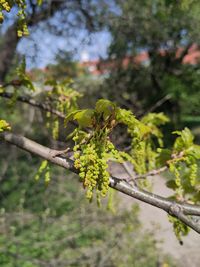Issued on April 24, 2025
The weather remains unsettled!
During the second half of the week, precipitation and cooling will continue to restrict the pollen count throughout Austria. No more rain showers are expected in the east of the country at the weekend, which means that the pollen count may increase again. In the west, it is likely to remain unstable and cool, which will slow down the pollen count in the longer term.
Due to the weather, birch pollen allergy sufferers in the west of Austria can look forward to a breather. The impact will probably only be low to moderate. In the east, the birch blossom is coming to an end and usually only causes minor symptoms.
Due to cross-reactions, the pollen from hornbeam, beech and oak can continue to intensify the symptoms for people who are sensitized to birch pollen. While hornbeam only plays a minor role, beech and oak are currently in full bloom and can release a lot of pollen if the weather is right.
In the south of Austria, hop hornbeam is also still causing stress and can also lead to stress in birch pollen allergy sufferers due to cross-reactions.
The blossoming of sycamore trees can still lead to allergic reactions in the vicinity of larger stands of sycamore trees.
In urban areas, the manna ash is increasingly blooming and can again cause stress in people who are sensitized to olive tree pollen. However, as this tree is mainly pollinated by insects, relevant pollen counts are only to be expected in the immediate vicinity of the plants. This also applies to the currently flowering lilac.
The white flakes that are currently increasingly visible in the air are poplar absorbent cotton. It cannot cause allergic symptoms as it is not pollen but poplar seeds and seed hairs. As the flight of poplar absorbent cotton usually coincides with the beginning of grass flowering, symptoms are often wrongly attributed to poplar.
Grass pollen can already lead to initial symptoms in thermally favorable locations. At present, the flowering is still very localized, but as soon as the weather improves again, the first relevant grass pollen exposure may also occur in other parts of the country. The first ryegrass, switchgrass, foxtail grass and tufted grass are currently flowering. However, according to the flowering readiness model, flowering is not expected to start across the board until the beginning of May.
In the meadow aspect, dock flowering in places can be an additional burden.
In some regions of the country, oilseed rape is in flower. To prevent possible symptoms, allergy sufferers should avoid being near these fields.
Other types of pollen in the ambient air: maple, boxwood, yew, mulberry, carnation, rose, horse chestnut, sour grass, walnut and cypress. These are of minor allergological importance.
| Flowering grasses | at |
|---|---|
Bregenz | 04.05.2025 |
Eisenstadt | 01.05.2025 |
Graz | 01.05.2025 |
Innsbruck | 01.05.2025 |
Klagenfurt | 02.05.2025 |
Linz | 02.05.2025 |
Salzburg | 02.05.2025 |
St. Pölten | 02.05.2025 |
Vienna | 01.05.2025 |
Munich | 05.05.2025 |
Bolzano | ready to bloom |
Forecast from 24.04.2025
Note: The data shown here are model data for the expected start of flowering. For more detailed information on the expected pollen count, please refer to the text forecasts.
Responsible for the content
AZ Pollenresearch GmbH
im Auftrag des Vereins Österreichischer Polleninformationsdienst in Kooperation mit der GeoSphere Austria.
Dr. med. Markus Berger, Dr. rer. nat. Johannes M. Bouchal und Lukas Dirr, MSc.
Wetterdaten und Prognosen basierend auf synoptischen Daten:
GeoSphere Austria, Bundesanstalt für Geologie, Geophysik, Klimatologie und Meteorologie (ehemals ZAMG)
zum Team


